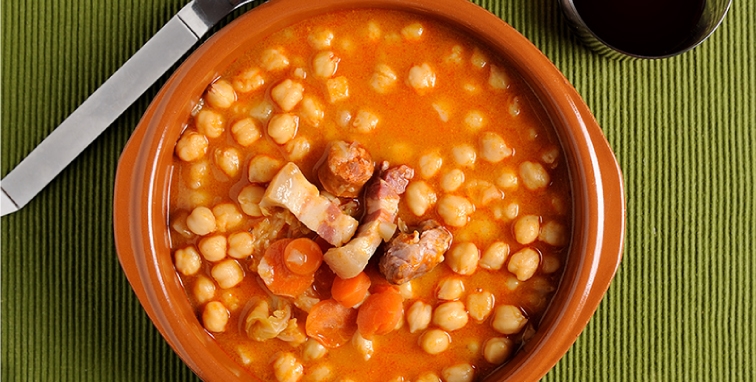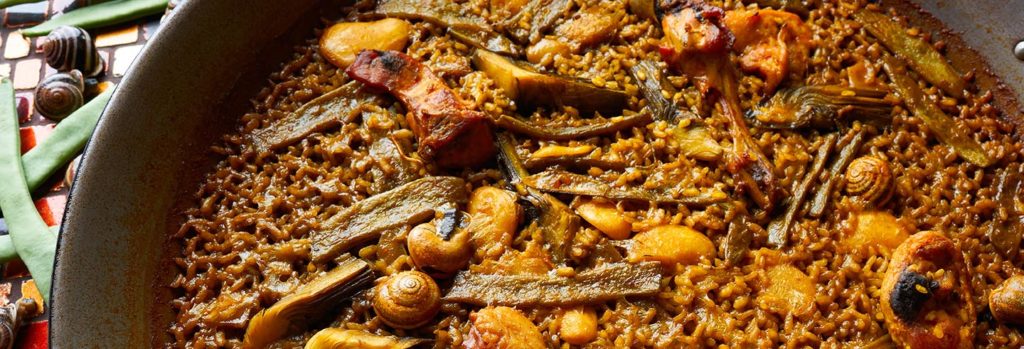In Spain, we love to cook. Spanish people love to cook and elaborate/create star-quality recipes. More precisely, the Spanish gastronomy is one of the richest cuisines in the world. The traditional spanish food, with their respective autochthonous suppliers, are excellent and our recipes are extraordinary and elaborate. In fact, each community has its own traditional spanish food, some of them have gone past frontiers and have made themselves popular in all of Europe. Although the quality and the care given when cooking, for example the Cocido madrileño, will not be the same as when eaten in Spain.
In this article we are going to discover which are the traditional spanish food. We will give special focus to spoon dishes, those made by our grandmothers when we were little kids. Our homemade meals made in our homeland.
Are you ready?
Traditional spanish food and their characteristics
There are a lot of varied traditional spanish food. However, in this article, we have made a selection of those typical Spanish dishes we consider to be most popular and recognised throughout all of the Iberian Peninsula and Europe.
Cocido madrileño, a Spanish cuisine signature.
When we refer to cocido madrileño, we are talking about a Spanish signature dish. This traditional dish comes as a synthesis of all Spanish cocidos. The composition of Cocido madrileño has not varied/changed in the last years. It is a very complete plate, with seasonal vegetables, chickpeas, fresh ground beef, salted pork meats, embutidos (sausages) and potatoes. The latter ingredient has been incorporated into the cocido in the last few years.
Also known as puchero, this traditional spanish food has history. All, from royals to the populace, know and enjoy this Cocido madrileño, especially during the wintertime because the puchero warms our bodies and helps to fight the cold.
Asturian bean stew, the north’s sanctuary
The Asturian bean stew is a sanctuary for those living up north. This traditional dish comes with fabes, a white-creamed coloured, long and flat, kidney-shaped bean variety, with a rather large size. It is the Holy Grail of Asturian bean stew for being the main ingredient. It is followed by chorizo and Asturian blood pudding. Eating Asturian bean stew in the Principado de Asturias is more than simple. But this recipe does not stop quiet. It is also known throughout the Camino de Santiago by those pilgrims who want to warm up their bodies and regain strength.
A traditional spanish food with history and many paths travelled.
The Paella Valenciana, a typical Sunday lunch dish
If we were referring to the Asturian bean stew as a sanctuary, the Paella Valenciana is a whole religion in Spain, especially in the Comunidad Valenciana. Leaving aside the Catholic terms, the Paella Valenciana brings together families and friends on weekends, especially on Sundays. It is quite a tradition, just like a typical Spanish dish. Paella is both the traditional spanish food and the name of the pan where the food is cooked. It is made in a pan-shaped metal container with a shallow bottom and handles.
Its repercussion is so great that the Valencian government, alongside the Regularity Council have drawn up the Denomination of Origin “Rice from Valencia”, a record that any paella under the name of Paella Valenciana must carry.
Ingredients: Chicken, rabbit, ferraura (green bean), garrofón, tomato, rice, olive oil, water, saffron and salt. Depending on the region. Ingredients such as garlic, artichokes, duck, paprika, snails or rosemary are allowed. These variants are also accepted within the denomination of authentic “Paella Valenciana”.
But there are also other types of paellas and rice that are very popular in Spain. The seafood paella, also known as Arroz a Banda or Arroz del Senyoret in Valencia are some examples. The greatest rival of the Paella Valenciana is the Alicante Paella. A reddish coloured rice due to the mince that is added based on Ñora (a small pepper), tomato and garlic called “Salmorreta”. What is clear is that the paella is a traditional spanish food, an acclaim for foreigners but, above all, a symbol for Valencians.
Migas from Extremadura
So far, we have seen consistent and typical spoon dishes. Migas from Extremadura could be considered a Spanish tapa. The origins of Migas goes back to the beginning of the bread, its main ingredient. Since the times of the Roman Empire, fried bread has been accompanied with pieces of meat. This traditional spanish food has evolved to become a benchmark in Spanish gastronomy, especially in Extremadura.
The ingredients of Migas from Extremadura are fried bread, garlic, oil, paprika from La Vera, torreznos and chorizos. A delicacy from Extremadura that has spread throughout the Spanish territory.
Other typical Spanish dishes
There are many traditional spanish food, much like the ones, the traditional spoon dishes with their own story that we have just seen. But there are essential products in our gastronomy that stand out from the rest. These products are very popular among the Spanish population, but especially among foreigners. The Potato omelette, Iberian ham or Galician octopus are the 3 jewels that reign on the Spanish scene.
These three bright stars nt only stand out from the rest, but they also dazzle the rest of the menu. They are served as an appetizer or as it is called in Spain, “Spanish tapas”.
Where to buy these traditional Spanish dishes if you live abroad?
We are aware that, if you live outside of Spain, it is not an easy task to cook them either, because the necessary ingredients for their elaborations are not easily found in European supermarkets, nor do they sometimes exist.
There are many ways to cook a traditional spanish food and each cook has their own special touch. Gastronomic Spain is your master key. Gastronomic Spain is the largest ever seen online store specialized in traditional spanish food for those who live in Europe and want to savour a piece of Spain from afar.
Gastronomic Spain has a very, very extensive catalogue with the best, top-quality and always at the best price typical products of Spanish gastronomy. Some examples are Iberian ham, Spanish omelette, preserves such as mussels or stuffed squid, typical sweets such as Donettes and drinks such as Horchata. There are also Liquors such as Orujo or any of the dishes previously seen. All this and much more are available in the Gastronomic Spain online store with totally FREE shipping to any point in Europe with orders over 79,99€.









